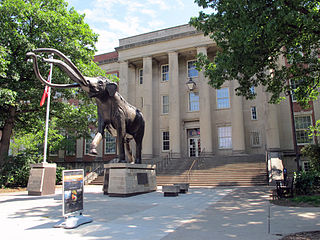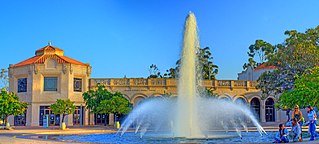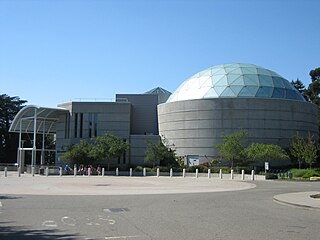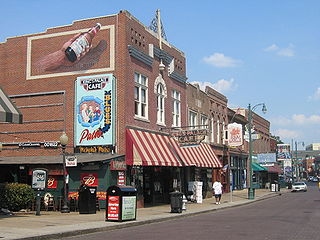The Oregon Museum of Science and Industry is a science and technology museum in Portland, Oregon, United States. It contains three auditoriums, including a large-screen theatre, planetarium, and exhibition halls with a variety of hands-on permanent exhibits focused on natural sciences, industry, and technology. Transient exhibits span a wider range of disciplines.

Cosmosphere is a space museum and STEM education center in Hutchinson, Kansas, United States. It was previously known as the Kansas Cosmosphere. The museum houses over 13,000 spaceflight artifacts—the largest combined collection of US and Russian spaceflight artifacts in the world, and is home to various space educational programs.

The University of Nebraska State Museum, also known as Morrill Hall, founded in 1871, is a natural history museum featuring Nebraska biodiversity, paleontology, and cultural diversity, located on the University of Nebraska–Lincoln City Campus near the corner of 14th and Vine Streets in Lincoln, Nebraska, United States. The museum houses Mueller Planetarium, a hands-on science discovery center, and the Elephant Hall, where visitors can see the world's largest articulated fossil mammoth among the collection of fossil elephants. Also featured are interactive paleontology exhibits, a dinosaur gallery, ancient life and evolution exhibits, wildlife dioramas, gems and minerals, American Indian and African exhibits, and a temporary exhibit gallery featuring rotating displays on diverse topics including photography, quilts and fine arts.

The Museum of Science (MoS) is a nature and science museum and indoor zoological establishment located in Science Park, a plot of land in Boston and Cambridge, Massachusetts, spanning the Charles River. Along with over 700 interactive exhibits, the museum features a number of live and interactive presentations throughout the building each day, along with scheduled film showings at the Charles Hayden Planetarium and the Mugar Omni Theater. Additionally, the Museum of Science is an accredited member of the Association of Zoos and Aquariums (AZA), being home to over 100 animals, many of which the museum gained after they were surrendered, confiscated, rescued or rehabilitated.

The Carnegie Science Center, soon to be The Daniel G. and Carole L. Kamin Science Center, is one of the four Carnegie Museums of Pittsburgh, Pennsylvania. It is located in the Chateau neighborhood. It is located across the street from Acrisure Stadium.

The Saint Louis Science Center, founded as a planetarium in 1963, is a collection of buildings including a science museum and planetarium in St. Louis, Missouri, on the southeastern corner of Forest Park. With over 750 exhibits in a complex of over 300,000 square feet (28,000 m2), it is among the largest of its type in the United States.

The Manitoba Museum, previously the Manitoba Museum of Man and Nature, is a human and natural history museum in Winnipeg, Manitoba, as well as the province's largest, not-for-profit centre for heritage and science education.

COSI, officially the Center of Science and Industry, is a science museum and research center in Columbus, Ohio. COSI was opened to the public on 29 March 1964 and remained there for 35 years. In 1999, COSI was moved to a 320,000-square-foot (30,000 m2) facility, designed by Japanese architect Arata Isozaki along a bend in the Scioto River in the Franklinton neighborhood. COSI features more than 300 interactive exhibits throughout themed exhibition areas.

The Fleet Science Center is a science museum and planetarium in Balboa Park, located in San Diego, California. It is at the east end of the El Prado Drive walkway, next to the Bea Evenson Fountain and plaza in central Balboa Park.

The McLaughlin Planetarium is a former working planetarium whose building occupies a space immediately to the south of the Royal Ontario Museum in Toronto, at 100 Queen's Park. Founded by a grant from philanthropist Colonel R. Samuel McLaughlin, the facility was opened to the public on October 26, 1968. It had, for its time, a state-of-the-art electro-mechanical Zeiss planetarium projector that was used to project regular themed shows about the stars, planets, and cosmology for visitors. By the 1980s the planetarium's sound-system and domed ceiling were used to display dazzling music-themed laser-light shows. The lower levels of the planetarium contained a gallery called the "Astrocentre" that featured space-related exhibits, related artifacts on the history of astronomy and was also home of the world's first commercial Stellarium

The Children's Museum of Indianapolis is the world's largest children's museum. It is located at 3000 North Meridian Street, Indianapolis, Indiana in the United Northwest Area neighborhood of the city. The museum is accredited by the American Alliance of Museums. It is 472,900 square feet (43,933.85 m2) with five floors of exhibit halls and receives more than one million visitors annually. Its collection of over 130,000 artifacts and exhibit items is divided into two domains: Arts & Humanities and the Natural Sciences. Among the exhibits are simulated Cretaceous and Jurassic dinosaur habitats, a carousel, a steam locomotive, and the glass sculpture Fireworks of Glass Tower and Ceiling. The museum's focus is family learning; most exhibits are designed to be interactive, allowing children and families to actively participate.

The Houston Museum of Natural Science is a natural history museum located on the northern border of Hermann Park in Houston, Texas, United States. The museum was established in 1909 by the Houston Museum and Scientific Society, an organization whose goals were to provide a free institution for the people of Houston focusing on education and science. The museum complex consists of a central facility with four floors of natural science halls and exhibits, the Burke Baker Planetarium, the Cockrell Butterfly Center, and the Wortham Giant Screen Theatre. In 2022, the museum received 1,520,000 visitors, making it seventh on the List of most-visited museums in the United States, and was the third most-visited U.S. science museum. Much of the museum's popularity is attributed to its large number of special or guest exhibits.

Chabot Space and Science Center, located in Oakland, California, is a center for learning in Earth and space science, which features interactive exhibits, planetariums, a large screen theater, hands-on activities, and three powerful telescopes.

The Phillip and Patricia Frost Museum of Science is a science museum, planetarium, and aquarium located in Miami, Florida, United States. The museum originally opened its Coconut Grove location across from Vizcaya Museum and Gardens in 1960. It relocated to Maurice A. Ferré Park in the downtown area adjacent to the Perez Art Museum Miami in 2017 after the closing of the Coconut Grove location in 2015.

The Museum of Arts and Sciences in Macon is a community museum in the U.S. state of Georgia. The facility includes four galleries with frequently changing exhibitions, the Discovery House with hands-on activities, live animal habitats, the Mark Smith Planetarium, nature trail, garden, store, auditorium, and classrooms. New exhibitions on fine arts, science topics, and the humanities are presented for periods of four to six months. The museum is open to the public daily and offers programs to schools and groups. The museum is a member of the American Alliance of Museums as of July 2019.

The Tulsa Air and Space Museum (TASM) is an aerospace museum in Tulsa, Oklahoma, United States. It is located in the northwest corner of the Tulsa International Airport property. It has 19,000 square feet (1,800 m2) of historical exhibits, hands-on activities, and vintage aircraft. A full-dome planetarium was added in 2006. The museum also has educational facilities for school visits, summer camps, and Scout groups.

Tourism in Memphis includes the points of interest in Memphis, Tennessee such as museums, fine art galleries, and parks, as well as Graceland the Beale Street entertainment district, and sporting events.

B. M. Birla Planetarium is a large planetarium in Chennai, India. The fifth B. M. Birla planetarium in the country, it is located at Kotturpuram in the Periyar Science and Technology Centre campus which houses eight galleries, namely, Physical Science, Electronics and Communication, Energy, Life Science, Innovation, Transport, International Dolls and Children and Materials Science, with over 500 exhibits. Built in 1988 in the memory of the great industrialist and visionary of India B. M. Birla, it is considered the most modern planetarium in India, providing a virtual tour of the night sky and holding cosmic shows on a specially perforated hemispherical aluminium inner dome. Other Birla planetariums in India include the M. P. Birla Planetarium in Kolkata, the Birla Planetarium in Hyderabad, and the planetariums in Tiruchirapalli and Coimbatore.
Science Centre, Surat is a multi-facility complex in Surat, Gujarat, India built by the Surat Municipal Corporation in 2009, the first of its type in western India. The complex houses a Science Centre, museum, an art gallery, an auditorium, an Amphitheatre and a planetarium. It has been designed by Ahmedabad based architectural firm, HCP Design, Planning and Management Pvt. Ltd.

Parque de las Ciencias is a science center and museum, part of the European Network of Science Centers and Museums (ECSITE), located in the city of Granada, Spain. Under the motto "A new kind of Museum", Parque de las Ciencias was founded in 1990 and opened in 1995. The museum has been solely directed by Ernesto Páramo Sureda since its establishment and its successive expansions. It occupies 70,000 m2 and holds permanent and temporary exhibitions including a planetarium, educational facilities, café, restaurant, bookshop, library, cinemas, etc. It has a cultural gallery ranging from 50 to 550 in number. Some of the museum’s highlights are its Plastination Lab and Restoration and Production Workshops.




















